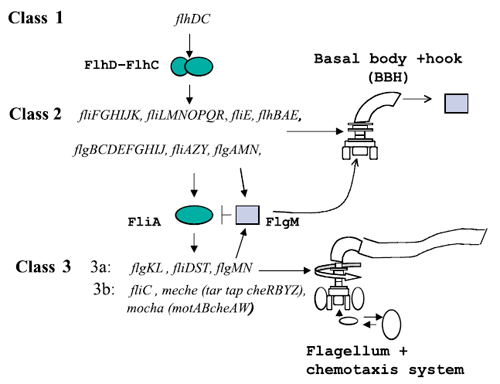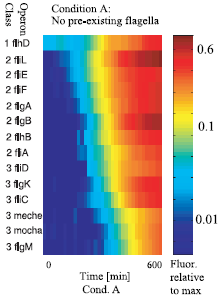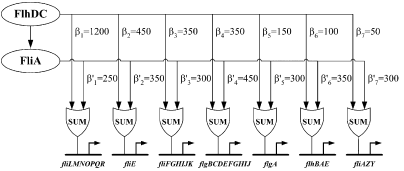Team:Paris/Flagella
From 2008.igem.org
(→Description of the genetic pathway that lead to flagella assembly) |
|||
| (21 intermediate revisions not shown) | |||
| Line 1: | Line 1: | ||
| - | |||
| - | |||
| - | |||
| - | |||
===Description of the genetic pathway that lead to flagella assembly=== | ===Description of the genetic pathway that lead to flagella assembly=== | ||
[[Image:Flagella.png|thumb|350px|Figure 1 : The genetically defined hierarchy of the flagellar operons in ''Escherichia coli''.]] | [[Image:Flagella.png|thumb|350px|Figure 1 : The genetically defined hierarchy of the flagellar operons in ''Escherichia coli''.]] | ||
The construction of ''E. coli'' flagellar system is organized into a complex hierarchy. The different parts of the flagella are successively assembled parts by parts. This architecture is also present in the network of genes that contributes to its set-up. | The construction of ''E. coli'' flagellar system is organized into a complex hierarchy. The different parts of the flagella are successively assembled parts by parts. This architecture is also present in the network of genes that contributes to its set-up. | ||
| + | |||
A global transcription factor FlhDC activates the synthesis of the flagella. This class 1 gene encodes a protein that activates the expression of class 2 genes. Those genes lead to the construction of the basal body of the flagella and its hook. Then FliA, a protein coded by a class 2 gene activates, with FlhDC to the expression of class 3 genes (''Figure 1''). | A global transcription factor FlhDC activates the synthesis of the flagella. This class 1 gene encodes a protein that activates the expression of class 2 genes. Those genes lead to the construction of the basal body of the flagella and its hook. Then FliA, a protein coded by a class 2 gene activates, with FlhDC to the expression of class 3 genes (''Figure 1''). | ||
| - | + | ||
| + | |||
| + | |||
===The expression of the flagellar genes is precisely ordered=== | ===The expression of the flagellar genes is precisely ordered=== | ||
| + | [[Image:order flag.png|thumb|left|221px|Figure 2 : The sequential expression of flagellar genes]]When the flagella system is turned on, the genes are expressed sequentially. flhD is expressed first, then the class 2 genes, and lastly the class 3 genes. At the heart of each class, the promoters are turned on sequentially, with significant delays, in the order ''fliL, fliE, fliF, flgA, flgB, flhB,'' and ''fliA'' (''Figure 2''). | ||
| + | |||
| + | The observed order correponds to the spatial position of the gene products during flafellar motor assemblu, going from the cytoplasmic to the extracellular sides. | ||
| + | |||
| + | ===A quantitative blueprint of the dynamics of the flagella gene network=== | ||
| + | [[Image:Blueprint.png|thumb|405px|Figure 3 : Quantitative blueprint of the dynamics of class 2 genes of the flagella gene network. β is the activation coefficient corresponding to a transcription factor and a promoter (unit : GFP/OD).]]<br>[http://www.ncbi.nlm.nih.gov/pubmed/15186773?ordinalpos=2&itool=EntrezSystem2.PEntrez.Pubmed.Pubmed_ResultsPanel.Pubmed_DefaultReportPanel.Pubmed_RVDocSum| Kalir ''et al.'' (2004)] evaluated the strength of the interactions between the different transcription factors fliA and flhDC and the class 2 promoters. They established a quantitative blueprint, considering the strength of the interactions and the functions that integrate multiple input (''Figure 3''). The structure of this network is typically a Multiple Output FFL, each class 2 gene is regulated by both flhDC and fliA, which is itself regulated by flhDC. This network is the logic circuit that can generate a FIFO behavior. | ||
| + | |||
| + | They determined that the input function for ''fliL'' promoter is a SUM gate in relation to FliA and FlhDC. | ||
| + | <br> | ||
| + | <center>It means that: '''Promoter_Activity([FlhDC],[FliA]) = Promoter_Activity([FlhDC],0) + Promoter_Activity(0,[FliA])'''</center> | ||
| + | |||
| + | The existence of a SUM input function for the other promoters has not been demonstrated but Uri ALON and his team assume that all the class 2 promoters have the same behavior. This is the first condition to create a FIFO. | ||
| + | |||
| + | The coefficients of activation for ''fliL'', ''flgA'' and ''flhB'' are ordered in the right way to behave as a FIFO : | ||
| + | <center>'''β<sub>1</sub><β<sub>5</sub><β<sub>6</sub>''' and '''β'<sub>1</sub>>β'<sub>5</sub>>β'<sub>6</sub>'''</center> | ||
| + | |||
| + | ===The dynamics is easily tunable, which is a great tool for engineering=== | ||
| + | The model suggests that, in order to change the response time, one can change the numbers on the arrows. For the earliest promoter, ''fliL'', decreasing β<sub>1</sub> should make the rise time longer and the maximal expression lower compared to the wild-type promoter. To experimentally change β<sub>1</sub>, Shiraz KALIR and Uri ALON inserted point mutations in the FlhDC binding site of the ''fliL'' promoter. Those mutations made the promoter activity later and weaker. | ||
===Bibliography=== | ===Bibliography=== | ||
*[http://www.sciencemag.org/cgi/content/abstract/292/5524/2080| Kalir ''et al.'' (2001)] | *[http://www.sciencemag.org/cgi/content/abstract/292/5524/2080| Kalir ''et al.'' (2001)] | ||
*[http://www.ncbi.nlm.nih.gov/pubmed/15186773?ordinalpos=2&itool=EntrezSystem2.PEntrez.Pubmed.Pubmed_ResultsPanel.Pubmed_DefaultReportPanel.Pubmed_RVDocSum| Kalir ''et al.'' (2004)] | *[http://www.ncbi.nlm.nih.gov/pubmed/15186773?ordinalpos=2&itool=EntrezSystem2.PEntrez.Pubmed.Pubmed_ResultsPanel.Pubmed_DefaultReportPanel.Pubmed_RVDocSum| Kalir ''et al.'' (2004)] | ||
| - | |||
Latest revision as of 15:56, 29 October 2008
Contents |
Description of the genetic pathway that lead to flagella assembly
The construction of E. coli flagellar system is organized into a complex hierarchy. The different parts of the flagella are successively assembled parts by parts. This architecture is also present in the network of genes that contributes to its set-up.
A global transcription factor FlhDC activates the synthesis of the flagella. This class 1 gene encodes a protein that activates the expression of class 2 genes. Those genes lead to the construction of the basal body of the flagella and its hook. Then FliA, a protein coded by a class 2 gene activates, with FlhDC to the expression of class 3 genes (Figure 1).
The expression of the flagellar genes is precisely ordered
When the flagella system is turned on, the genes are expressed sequentially. flhD is expressed first, then the class 2 genes, and lastly the class 3 genes. At the heart of each class, the promoters are turned on sequentially, with significant delays, in the order fliL, fliE, fliF, flgA, flgB, flhB, and fliA (Figure 2).The observed order correponds to the spatial position of the gene products during flafellar motor assemblu, going from the cytoplasmic to the extracellular sides.
A quantitative blueprint of the dynamics of the flagella gene network
[http://www.ncbi.nlm.nih.gov/pubmed/15186773?ordinalpos=2&itool=EntrezSystem2.PEntrez.Pubmed.Pubmed_ResultsPanel.Pubmed_DefaultReportPanel.Pubmed_RVDocSum| Kalir et al. (2004)] evaluated the strength of the interactions between the different transcription factors fliA and flhDC and the class 2 promoters. They established a quantitative blueprint, considering the strength of the interactions and the functions that integrate multiple input (Figure 3). The structure of this network is typically a Multiple Output FFL, each class 2 gene is regulated by both flhDC and fliA, which is itself regulated by flhDC. This network is the logic circuit that can generate a FIFO behavior.
They determined that the input function for fliL promoter is a SUM gate in relation to FliA and FlhDC.
The existence of a SUM input function for the other promoters has not been demonstrated but Uri ALON and his team assume that all the class 2 promoters have the same behavior. This is the first condition to create a FIFO.
The coefficients of activation for fliL, flgA and flhB are ordered in the right way to behave as a FIFO :
The dynamics is easily tunable, which is a great tool for engineering
The model suggests that, in order to change the response time, one can change the numbers on the arrows. For the earliest promoter, fliL, decreasing β1 should make the rise time longer and the maximal expression lower compared to the wild-type promoter. To experimentally change β1, Shiraz KALIR and Uri ALON inserted point mutations in the FlhDC binding site of the fliL promoter. Those mutations made the promoter activity later and weaker.
Bibliography
- [http://www.sciencemag.org/cgi/content/abstract/292/5524/2080| Kalir et al. (2001)]
- [http://www.ncbi.nlm.nih.gov/pubmed/15186773?ordinalpos=2&itool=EntrezSystem2.PEntrez.Pubmed.Pubmed_ResultsPanel.Pubmed_DefaultReportPanel.Pubmed_RVDocSum| Kalir et al. (2004)]
 "
"


